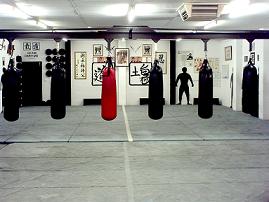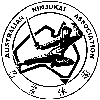| Home |
| About Ninjukai |
| Meditation |
| Juniors |
| Junior Camps |
| Displays |
| Instructors |
| Camps |
| Social Events |
| Classes |
| Calendar |
| Articles |
| Contact Us |
Training Ninjukai
Taijutsu Training | Ninjukai Training | The Dojo
<- Back to About Ninjukai
For more information on techniques studied, see The Syllabus
What is the syllabus, you may ask? How do we train our students? There are times when we are quite reluctant to use the word training, because it seems to imply a certain rigidity in approach and a methodised overview. Rather than use the word 'train', 'experience' would be more appropriate. There are 3 stages to the Ninjukai experience, known as SHU-HA-RI in Japanese.
-
SHU: The first stage involves the learning process, whereby the students learn all the basics in techniques. The White belt to Red belt covers this stage.
-
HA: This level shows the limitations of techniques. In a sense, students have to 'unlearn' everything from the previous level. Techniques can only go so far, so students learn and understand that spontaneity is the key to unlock the rigidity and inflexibility of techniques. The Ha level is where students are expected to undergo a degree of transformation, to go beyond the limitations of techniques. The Brown belt to the 3rd Dan Black Belt is worn during this stage.
-
RI: This stage traces a path of transcendence, where one frees oneself from techniques. In one's mind techniques do not exist any more: you and the techniques are one, inseparable. 4th Dan Black belt and above is required here.
The Taijutsu Training
Understanding the Body Potential
From the white belt to the Red belt at the Shu level, students learn about their body and its potential.
They are taught to understand that, in a situation, the body must respond as a whole. One cannot look at the body as made up of parts and try to use the part that one favours.
As such, Ninjukai Taijutsu is not a specialised system because it believes that to specialise is to isolate oneself from the surroundings.
Imagine a situation when an attacker grapples you in bed when asleep. So much for kicking techniques.
Or when your attacker bear-hugs you across your whole body and arms, at a time when you decide to specialise only in hand strikes.
So, students are made to understand the tremendous potential the body has, taken as a whole, and that all movements must be incorporated together so that the energy that is manifested can be efficiently utilised to meet the opponent's energy.
They are taught to realise the importance of physical fitness training. Endurance training, flexibility, and strength are emphasised.
All aspects of unarmed body techniques are taught to the students. These include:
|
Whilst the students are taught techniques, they are constantly reminded that their correct execution will be dependent on the body as a whole.
In any situation, the body posture is constantly changing, adapting: a punch can quickly change to a grappling technique, and a kick can be adapted to a throw.
All techniques become a flow to correspond to the situation. This leads to them understanding the Dynamics of Movement.
Most martial styles try to guide the way a student can move or react. They attempt to learn this through a series of set movements or patterns known as KATAS.
The Ninjukai Taijutsu practitioner believes that this can only give rise to rigidity and inflexibility. These are opposites to spontaneity.
What is important is naturalness in movement, and one's movements are to a great degree influenced by the opponent's movements.
By experiencing the dynamics of motion, the students learn to understand that an opponent or opposing force has to be neutralised not by opposing it, but by giving way, by flowing around it. Like water, one learns to be fluid.
Going beyond the Body Potential
This refers to the use of an external object as a tool to increase one's physical potential. The use of weaponry is practised in both the SHU and HA levels.
At the SHU level, the students are introduced to the different weapons and their corresponding striking and blocking methods.
At the HA level they learn to blend the weapon with the surroundings, otherwise it is seen as a useless foreign object.
That way, if the need arises, simple everyday objects may approximate the qualities of the weapons studied.
Weapons taught in the Dojo include:

-
Ninjato & Katana - traditional bladed weapons
-
Tanto - Ninja knife fighting techniques
-
Sai & Kama - farming tools whose use is adapted for combat
-
Manriki Gusari - Ninja chained weapon
-
Hanbo, Jo & Bo - 3ft, 4ft and 6ft wooden staff
-
Tonfa - Versatile wooden weapon
-
Jutte - a symbol of authority that can be converted into a weapon.
-
Yarito - a sword spear combination
The Ninjukai Training
Understanding the Mind Potential
The first level of the Ninjukai training is often termed the self discovery stage, where the student learns to probe his own mind and to understand fully its workings and tendencies.
The regular meditation classes held by the Shintao Society help the student to see the importance of balance and harmony as opposed to conflict and anxiety when it comes to the mind question.
One comes to understand the minds potential when one understands WU-HSIN. In the Tao, Hsin is the state of our everyday mind, one that is filled with concepts, dogmas and beliefs that become the source of our negative emotions, fear and anxieties.
At this stage there is a need to 'free' us from this state of mind.
Going Beyond the Mind Potential
The next stage is where the student starts to discover the 'universal' nature of the mind.
They are able to 'free' the mind of all negativism, beliefs and conflicts, thereby going beyond the boundaries of the mind.
Through meditation, they are able to tear down the boundaries created in the mind, and enter the spiritual realm to discover the infinity of one's consciousness.
In this second level, the student experiences and practices:
-
letting go (of all attachments)
-
opening out (going beyond the mind's boundary and realising its fullest potential)
|
|
The Training Venue: The Dojo |
 The Physical Set-up
The physical training is of great importance because of the inseparability of mind and body.
The physical training hall consists of mat areas where all aspects of Taijutsu can be practiced, including throwing and grappling techniques.
Surrounding the mat areas are the Makiwaras (strike boards) and punching bags, where members can improve on and strengthen their striking and kicking techniques.
Away from the mat area there is a separate Gym section where weight facilities and various exercise machines are installed for the members' use.
The Physical Set-up
The physical training is of great importance because of the inseparability of mind and body.
The physical training hall consists of mat areas where all aspects of Taijutsu can be practiced, including throwing and grappling techniques.
Surrounding the mat areas are the Makiwaras (strike boards) and punching bags, where members can improve on and strengthen their striking and kicking techniques.
Away from the mat area there is a separate Gym section where weight facilities and various exercise machines are installed for the members' use.
The Spiritual Set-up Physical training must go hand in hand with spiritual development. Up on the walls of the matted area are small padded meditation stools, these are used for seated meditation and as a head rest during laying down meditation. On the soft matted surface the students have less distractions as they begin their spiritual journey. The Shin Tao Society is responsible for the development of the spiritual section of the Dojo. Members of the public can join the Shin Tao Society and participate in its classes and activities without having to join the martial art section. Classes conducted by the Shin Tao society include Meditation, Contemplation, Self-Healing and Kuatsu.
For more information on techniques studied, see The Syllabus
<- Back to About Ninjukai


